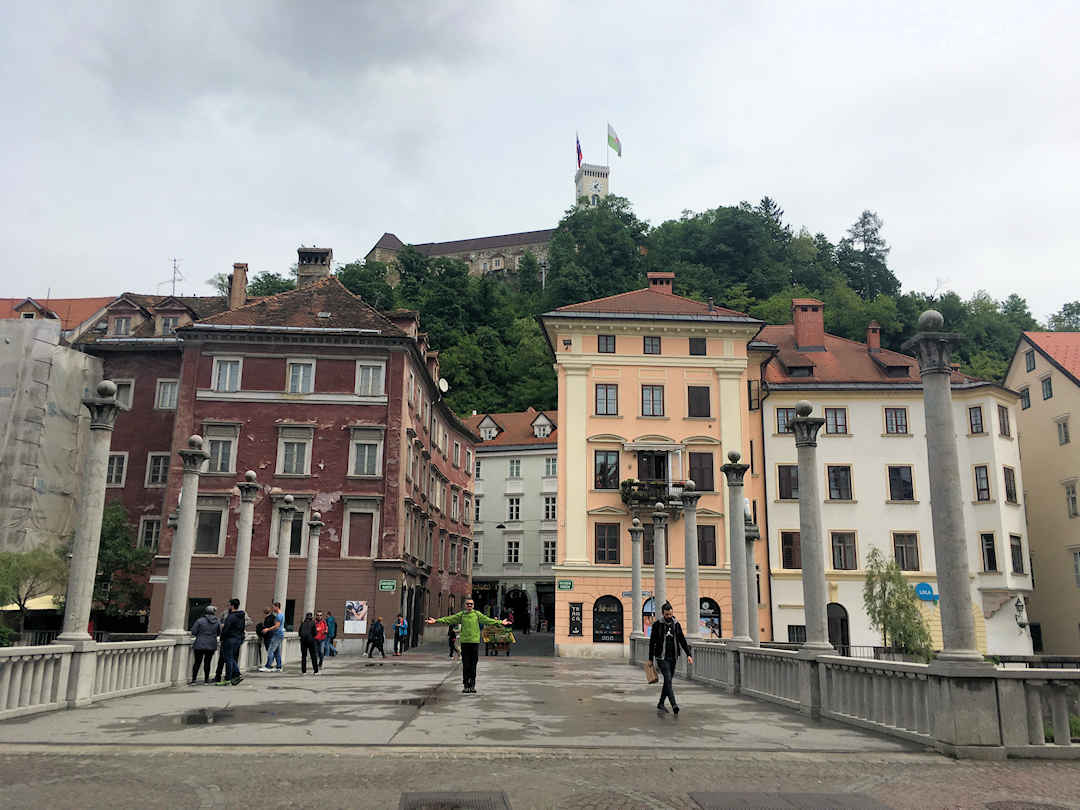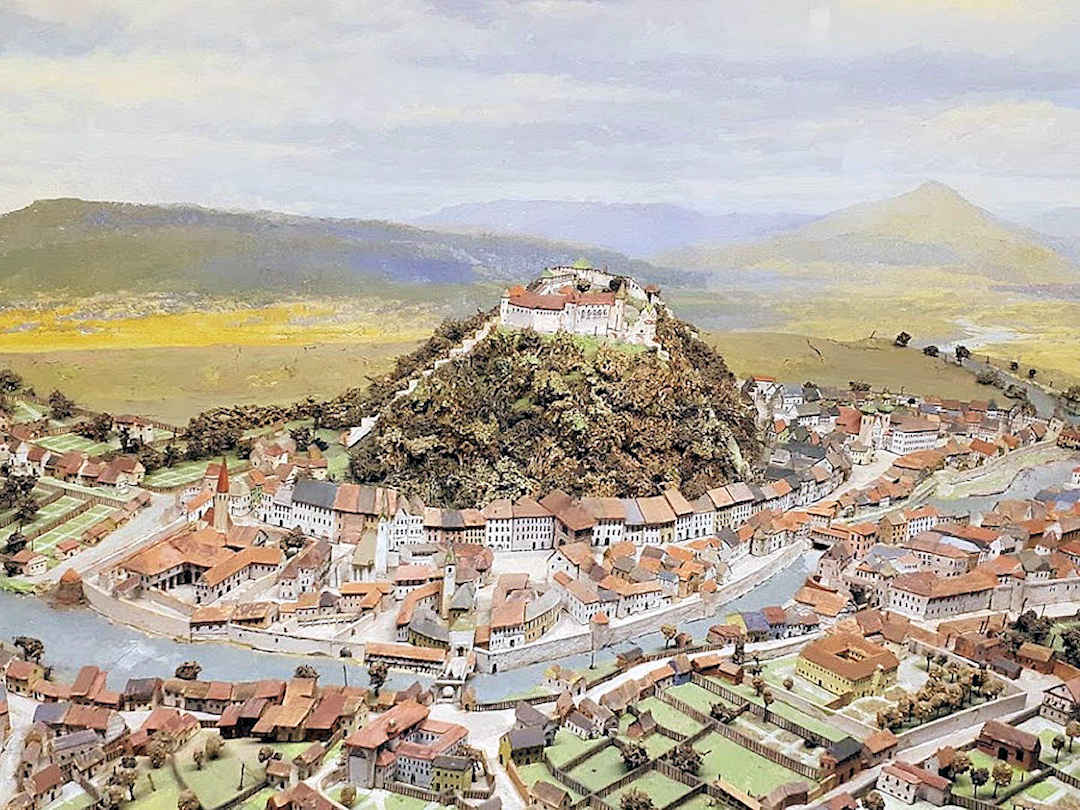With quaint medieval and pretty Austro-Hungarian buildings lining the Ljubljanica River, the Ljubljana Castle and the surrounding Alpine mountains, Ljubljana is one of the most picturesque capitals in Europe. It is also one of the most advanced destinations when it comes to sustainability, turning congested inner-city streets into pedestrian walkways, and implementing bike and electric car-share schemes to get even more cars off the road.
We visited Ljubljana, Slovenia recently and discovered a proud, green and cheerful city. We’ve now turned our experiences into this little itinerary for everyone else who’d like to explore Slovenia’s cute little capital.
Download your Sustainable Travel Checklist and show the world you care
As travellers, we should all be aware of our travel behaviour and its environmental, economic and social impact; and make conscious decisions about it. Too often, we hear negative stories in the media about tourists behaving badly.
Here is your chance to tick some boxes and check out what it really takes to travel with a sustainable mindset.
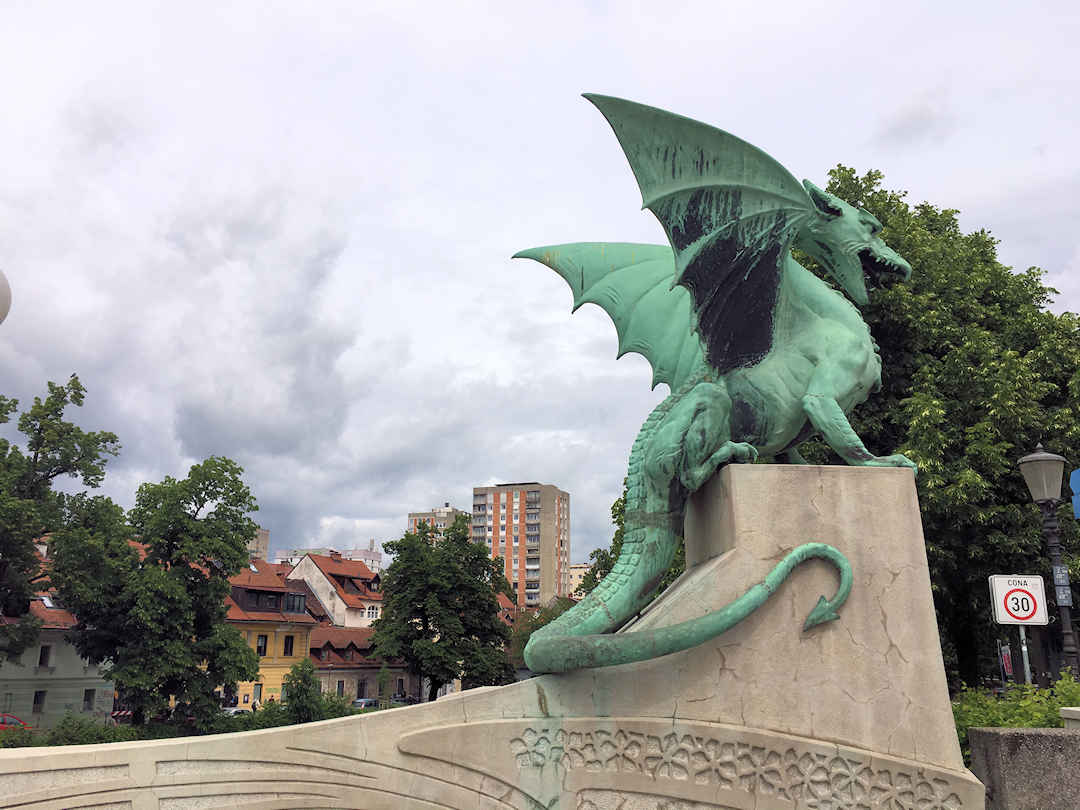
Dragons are everywhere in Ljubljana. They even have their own bridge.
The dragon is also in the city’s coat of arms, and there is even a Dragon bridge. So what’s with all those dragons?
Map of Accommodation, Points of Interest, Eateries and Transport
Below is a map of the recommended accommodation, points of interest, eateries and transport terminals/stops mentioned in this article.
Where to stay in Ljubljana?
Where to stay in Ljubljana will depend on
- what you want to experience
- your budget.
Like any modern city, accommodation options in Ljubljana range from backpacker dorms to Five Star Hotels.
It is recommended to book your accommodation in advance, especially if you plan to stay during the busy tourism season. So, securing your reservation well ahead of time is important. Below are some recommendations based on being in a central location, budget and the accommodation sustainability level achieved.
| Name | Location | Travel Sustainability Level | Price | Book Now |
|---|---|---|---|---|
| Hotel Slamic Ljubljana | Ljubljana | Level 3 | $$$ | Book Now |
| Vila Selena | Ljubljana | Level 1 | $$$ | Book Now |
| Oxford Apartments | Ljubljana | N/A | $$$ | Book Now |
| Back Private Rooms | Bled | N/A | $$ | Book Now |
Why is Ljubljana the city of dragons?
Ljubljana’s origins can be traced to the legend of Jason and the Argonauts. Having seized the Golden Fleece from King Aeetes of Colchis (in modern-day Georgia), Jason and the Argonauts fled across the Black Sea. They couldn’t get through the Bosporus to return to Greece, so they entered the mouth of the Danube River instead. As they travelled up the Danube, they reached the Sava River (in present-day Belgrade) and finally the Ljubljanica River and a big marshland, where Jason and the Argonauts decided to camp. The marshland though was home to a swamp monster (or dragon), which Jason fought and eventually killed.
While Jason and the dragon are mythical creatures, the presence of a swamp is more likely: Some say Ljubljana’s name originates from the Latin word Alluviana (flooded river). And even the German word that was given to Ljubljana during Austro-Hungarian times Laibach refers to a marshland.
How best to get around Ljubljana?
If you’re asking yourself this question because you’re thinking about hiring a car let me give you the answer right up front: If you’re planning to hire a car to travel around Slovenia (after you visited Ljubljana), save yourself a few Euros and only hire it once you leave the capital. You can explore Ljubljana very easily by public transport, by bike or on foot. Don’t worry, we’ll show you how.
To/from the airport by bus
While about 25km north of the capital, Ljubljana airport [Google Maps location] has good bus connections to both the Ljubljana Castle and the surrounding towns and villages. The ticket to Ljubljana costs EUR3.60 per adult one way. You simply buy the ticket from the driver.
Around the city
Ljubljana has an extensive public transport system consisting solely of buses (if you don’t count the cable car to the castle). To use Ljubljana’s buses, you need to have a rechargeable plastic card (called Urbana Card) as drivers do not carry cash.
The card can be purchased from various outlets, including newsagents and tobacconists, selected petrol stations and post offices, the main Bus Station [Google Maps location] and the Tourist Information Centres in Ljubljana [Google Maps location]. Some bus stops also have ticket machines, but we didn’t come across any.
If you buy your Urbana Card from the Tourist Information Centre (and keep the receipt), you can return your card at the end of your visit (to the same centre) and get the EUR2.00 fee back.
Before you buy the Urbana Card, calculate the amount you might need over the time you’re there, as you won’t get any money stored on the card back when you leave Ljubljana. You can always recharge the card as needed.
The good news is that one Urbana Card can be used between multiple people. Just tell the bus driver before you tap it on the card reader upon entering the bus. Purchasing a single ride allows you to change buses within 90 minutes at no additional charge. You can also use the card to pay for the cable car to Ljubljana Castle.
In the city centre
Once you reach the city centre, it is best explored on foot (or by bike).
Ljubljana Tourist Information Centre
We recommend that you drop by the Ljubljana Tourist Information Centre located at Adamic-Lundrovo nabrezje 2, next to the Tromostovje (Triple Bridge) to check out what is on at the city’s top attractions.
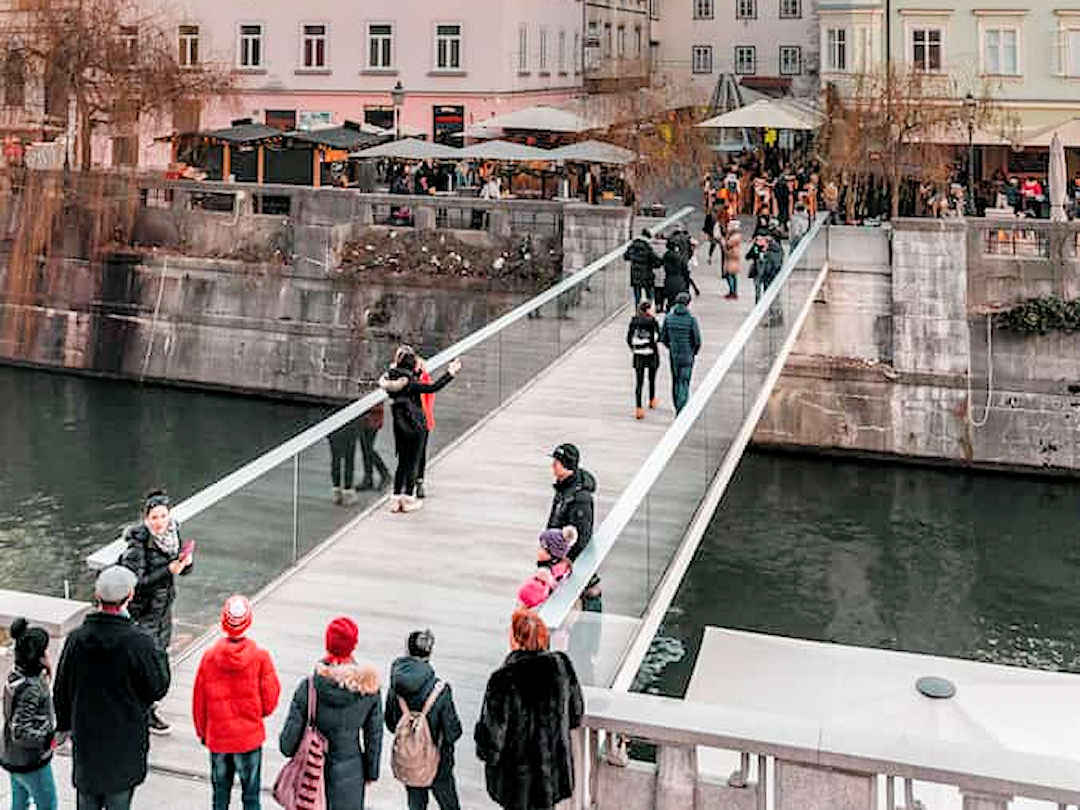
Ljubljana's city centre is best explored on foot | Image courtesy of Rok ZABUKOVEC on Unsplash
How to save money on transportation
Being flexible is what really pays when it comes to transportation and air travel in particular. Travel outside of peak season if you can. If you can't, fares might still be cheaper during certain times of the week and even hours of the day, so check websites like Skyscanner and Google Flights that allow you to see a whole month and all the options on any given date.
If there are several airports in the vicinity of your home (or in the vicinity of your destination) compare the prices between the different options. For example, flying to Mykonos and taking the ferry to Santorini might end up being way cheaper than flying from your home airport straight to Santorini.
We use and recommend the following online travel agents and service providers for our transportation needs:
Airfares
To find good flight deals, we use one-stop travel sites or travel aggregators. Each shows the cheapest airfares on any given day, so you can choose to fly a day/week/month earlier or later, pending your flexibility.
If you find a good deal, book it there and then as prices change constantly. Ideally do your research with your browser in incognito mode, as cookies will show booking sites how keen you are to do a certain trip, which may affect the price quoted – that goes for all online travel bookings (not just flights). The best fares generally go first, so planning ahead is important when it comes to (air) transportation. The same is true if you want to use air points/miles, as there is only a very limited number of seats available for any given flight. We tend to not actually go through the flight aggregators, but book with the airline/s directly. The price is usually the same but we have a direct contract with the airline (rather than with the middleman) in case something goes wrong.
If you plan to travel across multiple continents, you may want to compare passes that offer several destinations as a package (such as around-the-world fares offered by One World or Star Alliance members) vs booking each leg of your trip individually. If you are travelling during peak season those multi-destination packages may be a better deal than booking each leg individually. You can do overland sections on around-the-world tickets too, which means you could supplement your around-the-world ticket with cheap flights, bus and train rides in between destinations.
Vehicle rental (including relocations)
Unless your trip takes you across oceans, another way to save on transport is to look for vehicle/motorhome relocations. There are websites in many countries offering massively discounted one-way rates (often including fuel and/or insurance) to those driving a vehicle/motorhome from A to B within a certain period. These deals are fairly last minute, and A and B are usually bigger transport hubs, but if that’s an option just search for vehicle/motorhome relocation at your destination.
Speaking of vehicles: If you are planning to hire a vehicle at your destination, it also pays to shop around. We use and recommend Discover Cars, an aggregator website that allows you to search across major car rental companies at once. And you don’t have to pay for the hire until you pick up the car.
Hitchhiking
A final option to save on transport costs is… to hitch a ride. While Paul and I did it safely in Dominica on a public holiday (when there was no other option), and we have taken plenty of people along in our campervan in New Zealand, there are many countries we wouldn’t feel safe hitchhiking. Judge for yourself where and when you can and can’t do it.
Day 1 – Walking Tour, Arts and Culture
11:00
Start your first day with the Ljubljana Free (walking) Tour. The meeting point is the steps of the pink church at Prešeren Square. The tour lasts approximately two hours and takes you through the parts of the Old Town that are flanking either side of the Ljubljanica River between the Dragon and Cobblers bridges.
13:00
For lunch, we recommend that you sample Slovenian cuisine in one of the many traditional restaurants in town.

Afternoon
After lunch, head to the Metelkova Art Center to check out the street art and little hidden gallery spaces.
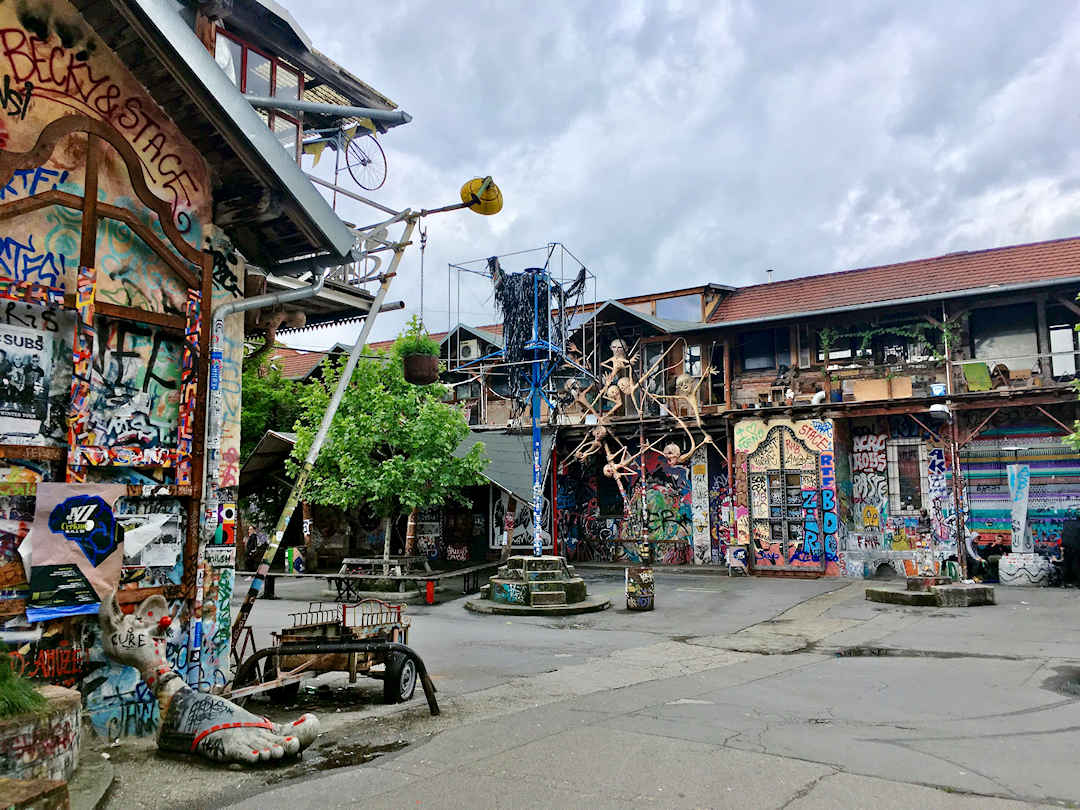
Visiting the Metelkova Art Center is like entering a different world
As you head back towards the Dragon Bridge and Old Town, visit the House of Experiments. This interactive little science museum is fun (whether you’re travelling with kids or not).
Evening
Enjoy the views over the city and watch the sunset from the Ljubljana Castle. Then head back into town for dinner.
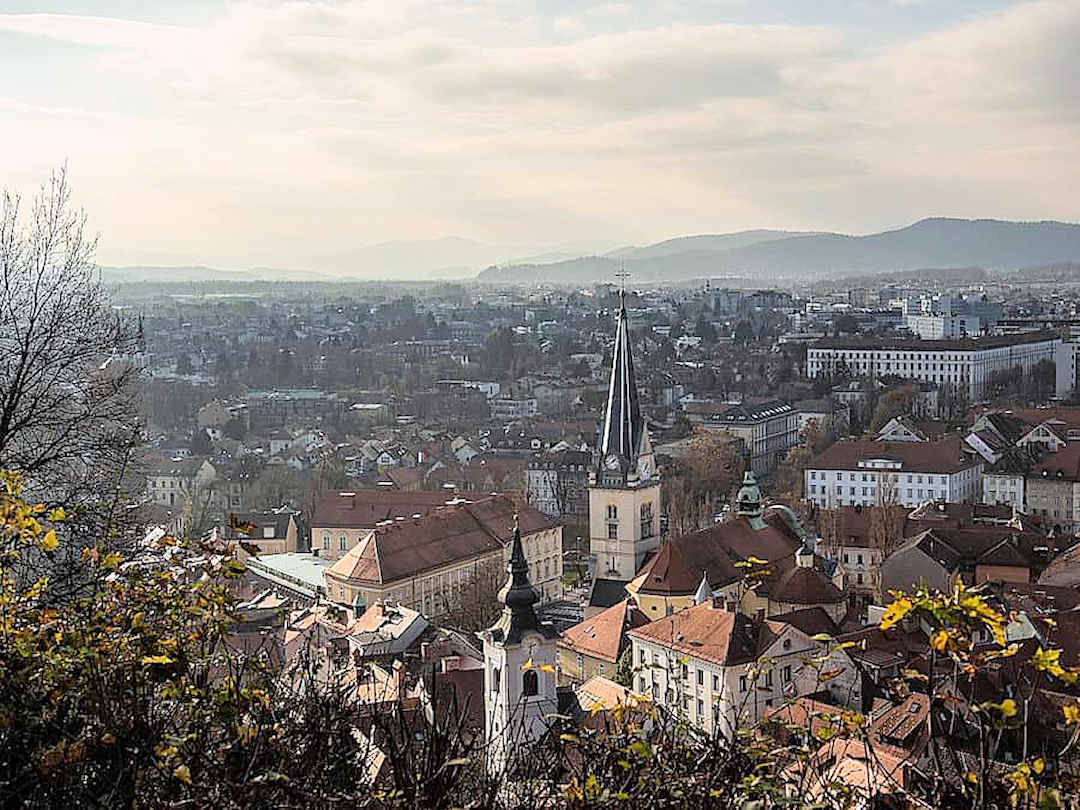
Enjoy (sunset) views from Ljubljana Castle | Photo by warpmike on Pixabay
Day 2 – Nature, Culture and Music
Morning
We suggest you spend the morning of your second day in Ljubljana exploring the huge green space that sits smack in the middle of the capital: Tivoli Park, and the Rožnik and Šiška hills. You can walk/hike around the park and/or hire a bike at one of the many bike-share stations dotted all around the city. Signing up for the city’s bike-share scheme is super easy.
While Tivoli Park is nice and flat, inviting you to a stroll around its water lily-covered pond, and along Jakopič Promenade [Google Maps location] with its open-air gallery, the adjacent hills of Šišenski Hrib and Cankarjev Vrh rise to 429 metres and 394 metres, respectively. The hilly park is crisscrossed by gazillion hiking and bike trails – you’ll be spoilt for choice.
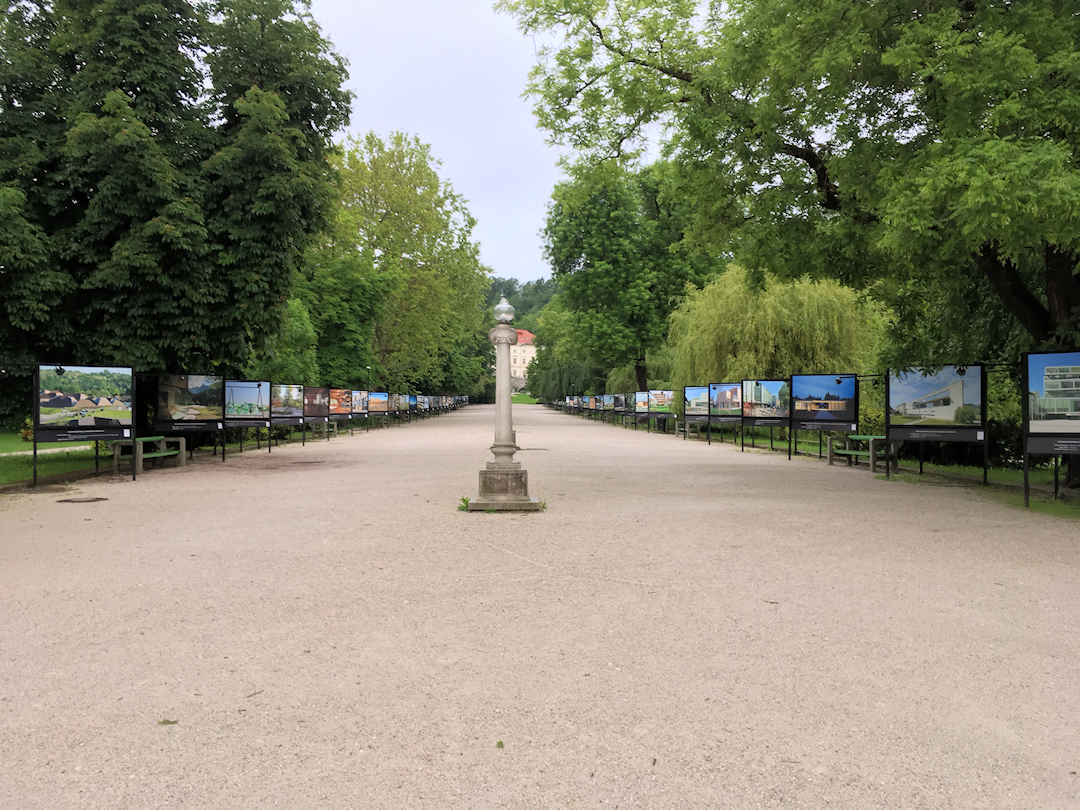
Check out Tivoli Park with its open air gallery along Jakopič Promenade and its water lily covered pond
A popular loop trail from/to Tivoli Park is Jesenkova Pot (marked blue on the map below). Named after Fran Jesenko, a Slovenian botanist, the educational trail explains the different tree species you encounter along the path.
Another loop trail (marked red on the below map), also from/to Tivoli Park, takes you along Podrožniška pot to Cankarjev Vrh. There you can visit the Church of St Mary’s Visitation (Cankarjev Vrh 1, 1000 Ljubljana, Slovenia, +386 1 242 93 00) and enjoy a beer (and meal) at the old inn (in summer with a beer garden).
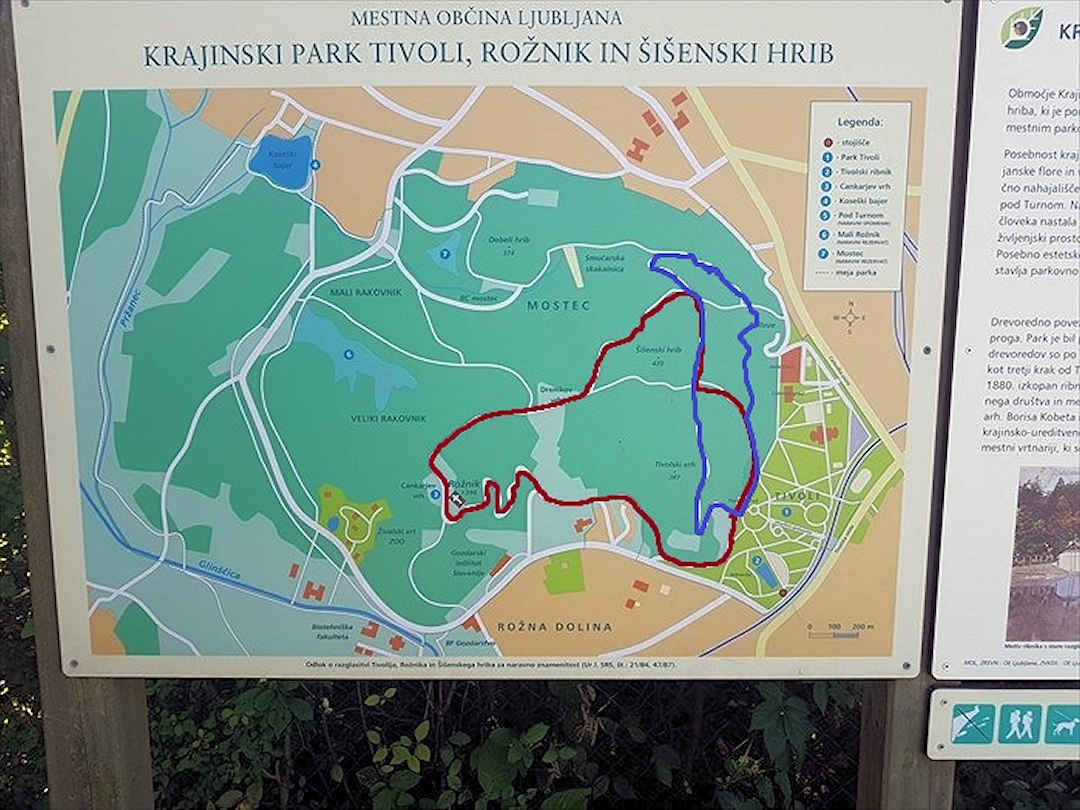
Tivoli Park, and Rožnik and Šiška hills are crisscrossed by hiking and bike trails – you’ll be spoilt for choice
From Cankarjev Vrh, you continue (along Pot na Drenikov Vrh and Tivoli) around Šišenski Hrib and back to Tivoli Park.
If that sounds complicated don’t worry. The same maps (as the picture below) are dotted around the park, and there are heaps of trail markers – you won’t get lost. Besides, there are always MapsMe and Google Maps.
If you cycle you could also include a loop around the Mostec ski jumping complex and past the Zoological Garden, along Večna Pot.

Enjoy views like this from Rožnik Hill | Photo by TravelDudes on Pixabay
Afternoon
Spend the afternoon of your second day in the Slovenian capital with a visit to the City Museum [Google Maps location] and/or Plečnik House [Google Maps location]. Both are located not far from Tivoli Park (and each other).
Housed in the historic Auersperg Palace, the City Museum is excellent if you want to learn more about Slovenia’s and Ljubljana’s history.
Speaking of Ljubljana’s history: Jože Plečnik is for Ljubljana what Antoni Gaudí is for Barcelona – the architect behind many of the buildings you have passed on your walks around the city (and the famous triple lane bridge).
Visiting Plečnik’s former home and studio, you can learn more about the architect who had such an immense impact on the development of Ljubljana as well as other cities in the former Austro-Hungarian empire, like Vienna and Prague. There are plans, sketches, photographs and models (including of projects that were never realised).
Recommended movies to provide inspiration for your next trip
If you're looking for some travel inspiration, why not turn to the big screen? Movies have the power to transport us to different places, sparking our wanderlust and making us dream of new adventures. And with 80+ films to choose from, covering classics and hidden gems all around the world, you will be planning your next adventure in no time.
Evening
If you’re up for some live music or a dance theatre performance after dinner check out what’s on at Prulček and Plesni Teater Ljubljana [Google Maps location]. Both are conveniently located side by side in the Prule neighbourhood.
Want to carry on to Lake Bled the next day?
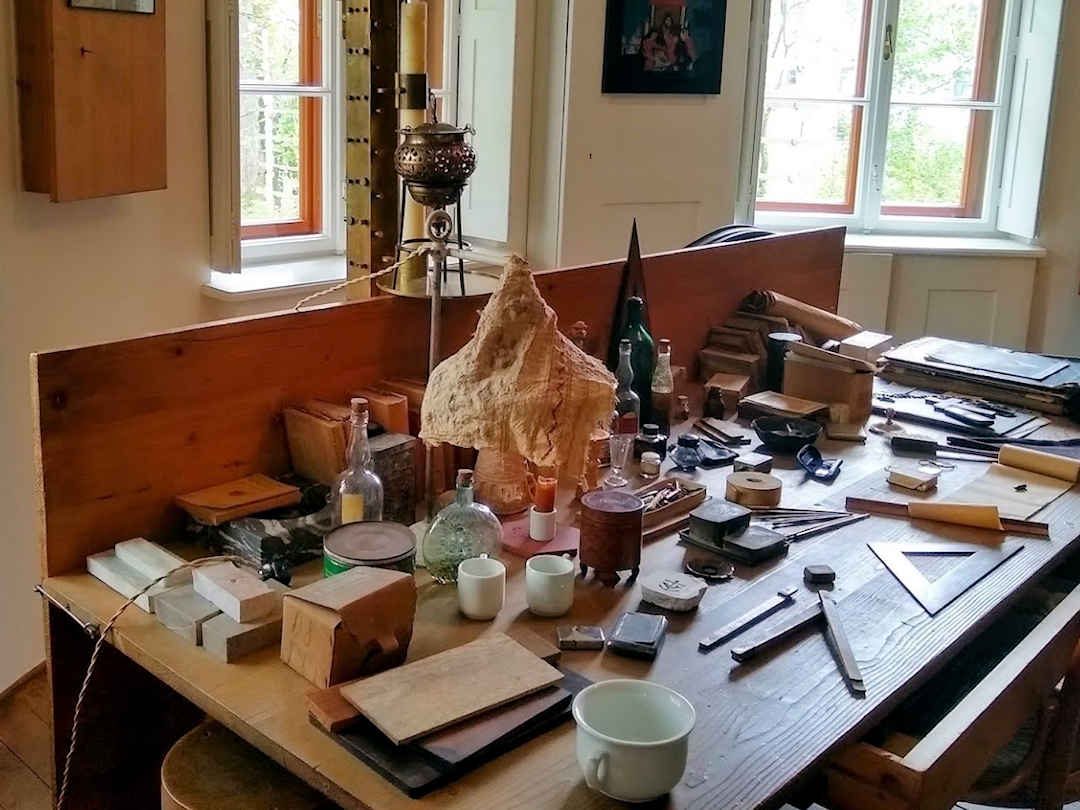
Plečnik House is full of plans, sketches, photographs and models (including of projects that were never realised)
How to save money on experiences
Free activities or experiences
Many activities (and some of our most treasured experiences) are free or cost very little. On our journeys, we have
- Visited many museums free of charge (including the Colosseum and Forum in Rome which are free on the first Sunday of the month)
- Joined Al Green’s Baptist Church Service in Memphis (rather than pay the exorbitant entry fees at nearby Graceland)
- Attended free guided walking tours around the world (you pay a tip at the end based on your budget and how much you liked the tour)
- Did countless self-guided walks and used public transport to get to know a city
- Hiked in the Andes in Ecuador and climbed volcanoes in the Caribbean
- Swam and snorkelled at countless beaches, using tree shade rather than paying for parasols; and
- Attended free performances and danced with locals in Cuba.
Just search for free activities in your destination and chances are someone has made a nice list for you already.
Paid Experiences
Paying for experiences or activities can add up quickly, especially if you're travelling as a family. Make use of family passes (if available). Look out for special deals and discount coupons. If you travel in a group, it may also pay to book a private tour and share the cost. Shop around - here are some of the service providers we have used and can recommend:
Have you seen our other articles about Slovenia?
Discovering the local cuisine is part of the fun of travelling. It also makes for a more immersive and authentic experience if you eat in a local restaurant, chat with the wait staff/chef and learn more about the food on your table. So, while in Slovenia, make sure you taste a few traditional dishes. In our food guide for (Western) Slovenia, we talk about dishes to look out for on the menu (and where to have them).
And if you’re about to plan your trip and wonder how much to budget check out how affordable it is to visit Slovenia.
If you have visited Ljubljana in Slovenia recently, what was your experience like? What other tips can you share?
I wrote this Ljubljana travel guide based on my own experience. If you have been to Ljubljana and you have something to add, please feel free to contact me. If you liked my article and tips and found them helpful, I would appreciate it if you could share them with your friends and family via the Share buttons below. Even better, link to the page from your personal blog or social media platforms.

